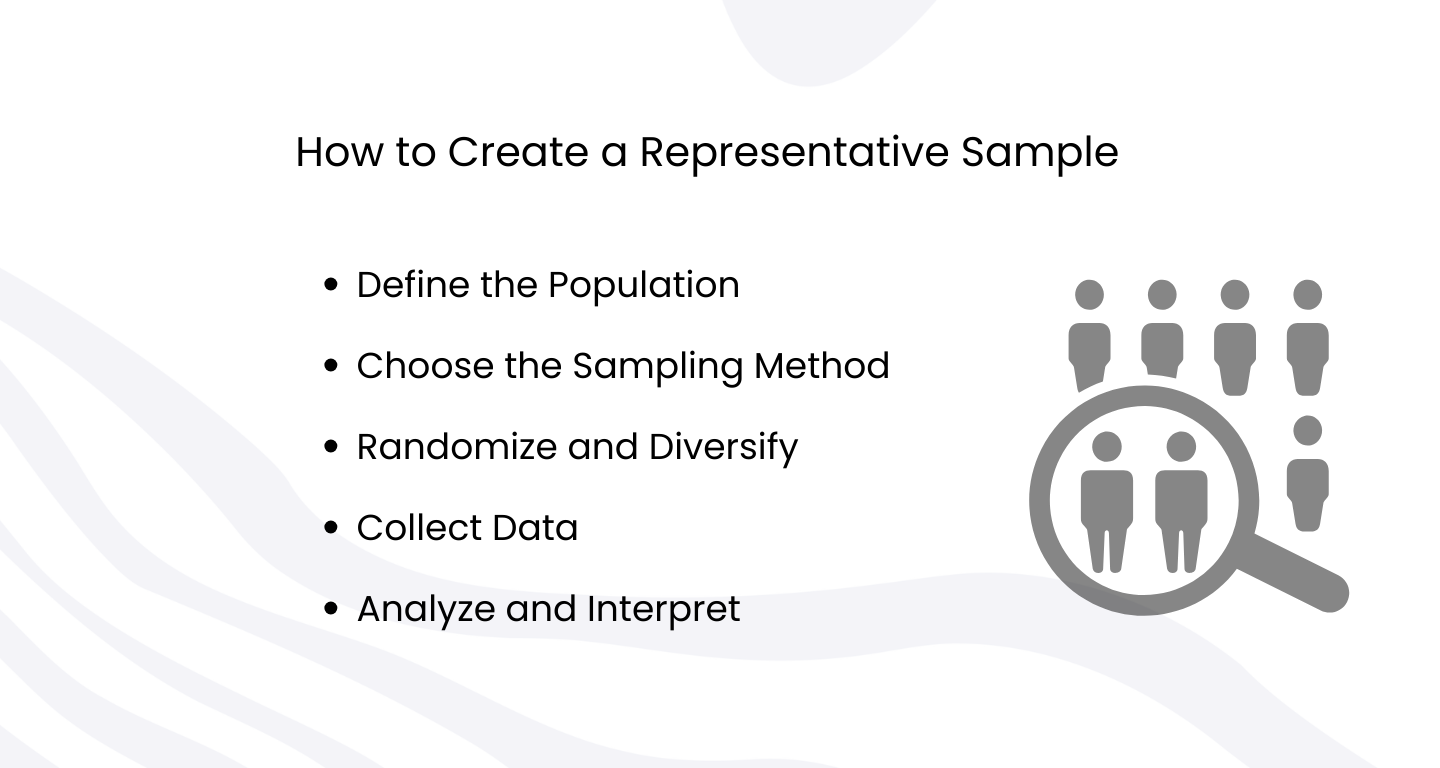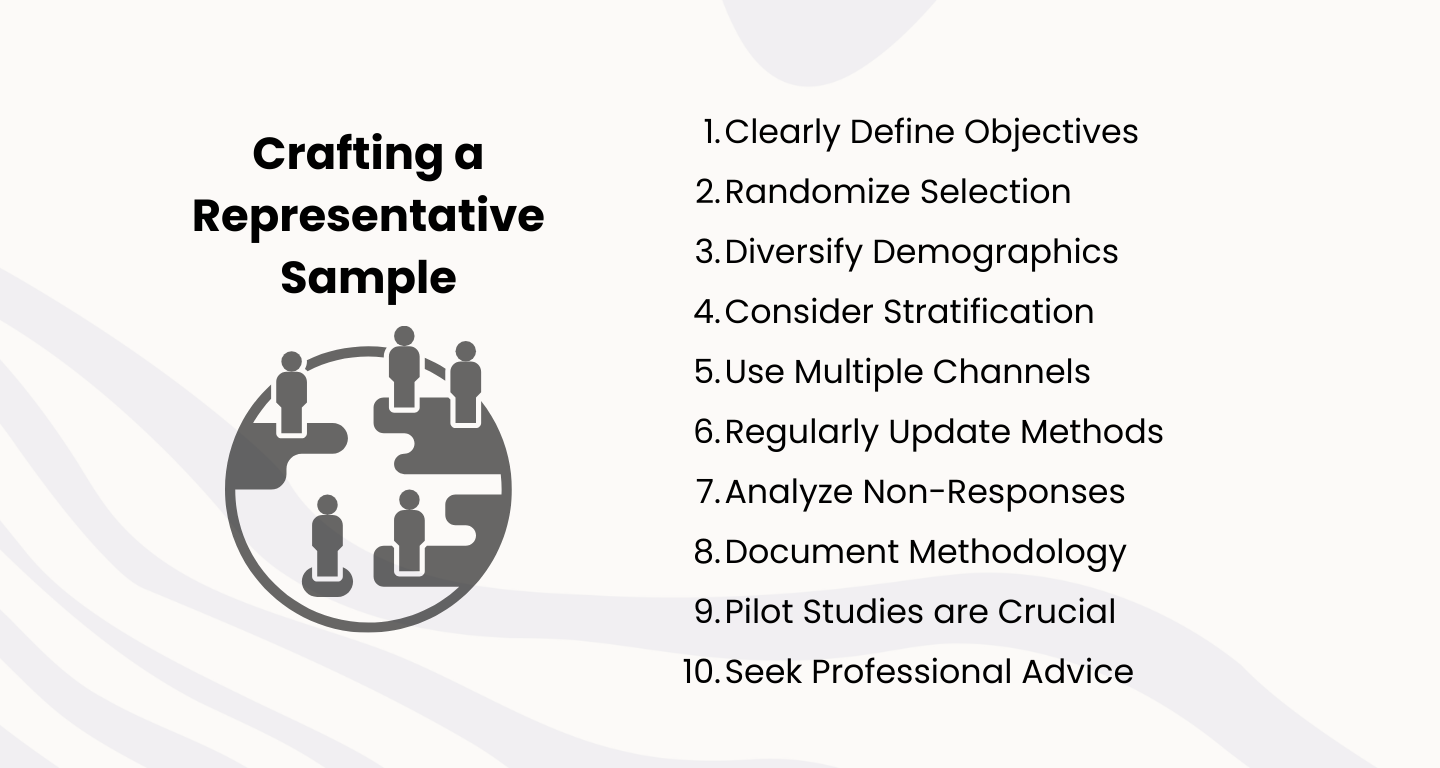Representative Sample: Understanding its Importance in Surveys

Kate Williams
Last Updated: 29 May 2024
12 min read

Imagine surveying 8 billion unique individuals, all with their own traits and characteristics. And, not just survey, but understand the intricate details. It’s like counting the very grain of sand in the beach. Practically impossible! This is where the concept of samples comes into play. Samples act as our lens, enabling us to study these vast populations in manageable portions. Now, let’s zoom in on one exceptional method: the Representative Sample. What is it? Why is it so important?
What is a Representative Sample: Definition
Let’s talk statistics now. A representative sample is a subset of a larger population that accurately reflects the key characteristics of that entire population. Imagine an artist capturing the essence of an entire landscape within a single frame. Similarly, a representative sample is a meticulously chosen subset of a larger population that intricately mirrors the key characteristics of the whole.
This selection process follows rigorous methodologies and statistical techniques. Every member within this sample is not just a number. They help us understanding the collective pulse of the entire population. By analyzing this microcosm, researchers gain profound insights into the patterns of society. How will that help? It enables accurate predictions, informed decision-making, and a deeper understanding of the complexities of the world.
What is a Sample?
Imagine trying to grasp the flavor of an entire feast by tasting a single, well-prepared dish. That’s precisely what a sample does—it condenses the vastness of a population into a manageable subset. This allow researchers to draw meaningful conclusions without drowning in a sea of data.
A sample is like a small, yet meticulously chosen, portion of a larger population. Researchers employ various techniques to ensure the sample mirrors the population’s key characteristics, be it age, gender, income, or education level.
But, why is this important? Because studying an entire population is like trying to read an entire library—it’s exhaustive and illogical! A sample distills the essence, allowing researchers to analyze patterns, identify trends, and make predictions. It’s the foundation upon which reliable statistics, market insights, and scientific breakthroughs stand.
Types of Sampling
There are basically two types of sampling: Probability Sampling and Non-probability Sampling. What are they?
Probability Sampling
Imagine the population as a grand book, and each member is a unique page. Probability sampling ensures that each page has an equal chance of being read. It’s the gold standard of sampling methods! This method operates on the principle of randomness, where every individual within the population has a known, nonzero chance of being selected. Think of it as a fair and unbiased lottery, where everyone holds a ticket, ensuring that the sample is a true reflection of the population.
Examples of Probability Sampling
- Simple Random Sampling: Like drawing names from a hat, every member of the population has an equal likelihood of being selected.
- Stratified Sampling: The population is divided into distinct strata or groups, and samples are then randomly chosen from each stratum, ensuring representation from every segment.
- Systematic Sampling: Every nth member of the population is selected after a random start. It’s akin to sampling every 10th item from a production line to assess quality.
Non-Probability Sampling
Non-probability sampling, on the other hand, explores the more nuanced shades of the population. It doesn’t guarantee that every member has a known chance of being selected. Instead, it relies on the judgment of researchers, making it more subjective. While it might not offer the same level of statistical precision, it still provides valuable insights.
Examples of Non-Probability Sampling:
- Convenience Sampling: Researchers select individuals who are most convenient or readily available. It’s like interviewing people in a shopping mall—a convenient yet limited representation of the population.
- Judgmental or Purposive Sampling: Researchers handpick specific individuals based on their expertise or knowledge, making this method common in qualitative research where specialists’ opinions are essential.
- Quota Sampling: The population is divided into subgroups and then individuals are chosen non-randomly from these subgroups until predetermined quotas are met. This method is often used in market research to ensure a diverse sample.
Representative Sample: Methods
Creating a representative sample involves intricate techniques. Surveys and questionnaires are popular tools, but ensuring they are well-crafted and unbiased is crucial. Data analysis methods like regression and correlation help in understanding relationships within the sample, leading to more accurate predictions for the larger population.
How to Create a Representative Sample
Well, understanding the subtle nuances of a population is like solving a complex puzzle. So, how do we assemble this puzzle effectively? Let’s look at the methods in detail:

1. Define the Population
The first step is clarity. Precision is key!
Define the target population meticulously. Whether it’s the residents of a city, the users of a specific app, or potential buyers of a product, a clear definition ensures the sample aligns perfectly with the intended audience.
2. Choose the Sampling Method
The method chosen depends on the research objectives. If the aim is unbiased representation, simple random sampling might be the tool of choice, ensuring every member has an equal chance of being chosen. For more intricate studies, stratified sampling might be employed, diving deep into specific demographics within the population.
3. Randomize and Diversify
Randomization is the heartbeat of unbiased sampling. Randomly selecting individuals eliminates human biases, ensuring fairness.
Additionally, diversity is key. A truly representative sample captures various dimensions of the population, such as age, gender, ethnicity, and socioeconomic status. Just as an artist blends colors for the perfect shade, researchers blend demographics for a balanced sample.
4. Collect Data
Surveys, questionnaires, and interviews are the tools of the trade. Crafted with precision, these instruments gather relevant information from the selected individuals. Each response is a stroke on the canvas, contributing to the overall portrait of the population.
Read More: 21 Effective Customer Satisfaction Questionnaire Examples
5. Analyze and Interpret
Once the data is collected, the real magic happens. Statistical tools, like regression analysis or chi-square tests, dissect the data, revealing patterns and insights. This step is akin to a restorer delicately bringing out the hidden details in an old painting, allowing researchers to interpret the population’s nuances.
You see, when done right, it transcends mere numbers. This is where advanced platforms come to use. For instance, SurveySparrow can easily help you create engaging surveys, collate feedback, analyse the data and take informed decisions! Ensure your surveys capture the diverse perspectives of your audience effectively.
Imagine getting to do all this in a single platform! Makes everything so much easier, right? For those of you who haven’t heard of the platform yet, here’s the chance. Try it out for free today!
14-day free trial • Cancel Anytime • No Credit Card Required • No Strings Attached
How to Avoid Sampling Bias
Sampling bias happens when you don’t look at the whole picture. In research, sampling bias happens when we only look at a specific group of people and ignore others. It can make research results wrong because they don’t represent everyone. It’s like trying to guess the taste of a soup by only tasting one spoon; you might miss out on important flavors.
Here are methods to avoid it:
- Diversify Your Sample:
Include a mix of people from various backgrounds and demographics to ensure a well-rounded representation. - Randomize Your Selection:
Use random methods, like drawing names from a hat, to give every individual an equal chance of being chosen. - Be Aware of Researcher Bias:
Remain mindful of personal biases to prevent unintentional influence on sample selection. - Use Multiple Data Sources:
Gather data from various sources to create a diverse and comprehensive sample. - Blind Surveys and Interviews:
Conduct surveys and interviews without knowing specific participant details to minimize appearance-related biases. - Regularly Review and Adjust Methods:
Periodically assess and adapt sampling methods to account for demographic changes and evolving factors. - Seek Expert Guidance:
Consult statisticians and social scientists to ensure rigorous and unbiased sampling techniques. - Conduct Pilot Studies:
Test research methods on a small scale to identify and address biases before the main study.
Read More: Sampling Bias: Definition, Methods, & How To Avoid
Representative Sample: Advantages and Disadvantages
Advantages
- Provides accurate insights into larger populations.
- Cost-effective compared to surveying entire populations.
- Enables precise predictions and informed decision-making.
Disadvantages
- Vulnerable to biases if not carefully constructed.
- Limited by budget and time constraints.
- Maintaining representativeness over time can be challenging.
Representative Sample: Example
Let’s say you are aiming to improve your product based on user preferences. But, your user base is vast and diverse, ranging from startups to enterprises, each with unique needs and preferences.
Creating a representative sample in this context means selecting users from various industries, company sizes, and usage patterns. For instance, you could randomly choose a group of users from different sectors—healthcare, finance, education—and from various company sizes—small startups to large enterprises.
By surveying this carefully chosen sample, you can understand the diverse requirements of your entire user base. For instance, if a majority of users from different sectors request a specific feature, it indicates a widespread need. This insight guides your product development, ensuring you cater to the varied demands of your entire customer base, making your SaaS product more versatile and user-friendly.
How to Determine if a Sample is Representative of the Population
Statistical tests like chi-square tests, t-tests, and ANOVA (Analysis of Variance) help researchers assess if their sample accurately represents the population. These tests compare the characteristics of the sample with the known attributes of the entire population, ensuring alignment.
Here’s are the steps:
- Define Population Parameters: Clearly outline the characteristics of the entire population.
- Match Key Demographics: Ensure the sample mirrors essential demographics of the population.
- Conduct a Pilot Test: Test a small sample to check if it aligns with the population’s traits.
- Use Statistical Measures: Apply statistical tools like chi-square tests to compare sample demographics with the population.
- Evaluate Response Rates: Consistent response rates across demographics indicate representativeness.
- Cross-Verify with External Data: Compare sample data with external sources like census data for validation.
- Assess Diversity of Responses: A truly representative sample showcases diverse opinions and perspectives.
- Seek Expert Opinion: Consult research experts for a comprehensive evaluation.
Crafting a Representative Sample: Best Practices
Creating a representative sample is both an art and a science. Here are key best practices to ensure your sample accurately reflects the diversity of the population and delivers reliable insights:

1. Clearly Define Objectives
Define your research goals clearly, outlining what aspects of the population you want to study. Clarity guides the selection process.
2. Randomize Selection
Use random methods to choose participants. Randomization removes biases, ensuring fairness in selection.
3. Diversify Demographics
Include a mix of age groups, genders, ethnicities, and socioeconomic backgrounds. A diverse sample captures the richness of the population.
4. Consider Stratification
If your population has distinct groups (like different age brackets), use stratified sampling. It ensures representation from each subgroup.
5. Use Multiple Channels
Reach out through various platforms—online surveys, phone interviews, in-person questionnaires. Multiple channels enhance outreach, capturing varied perspectives.
6. Regularly Update Methods
Stay updated with evolving demographics and technologies. Regularly review and update your sampling methods to stay relevant.
7. Analyze Non-Responses
Understand why some people didn’t participate. Analyzing non-responses provides insights into potential biases.
8. Document Methodology
Document your sampling methods meticulously. A well-documented process enables transparency and replication by others.
9. Pilot Studies are Crucial
Conduct small-scale pilot studies to identify potential issues before the main research. Pilots ensure your methods are effective and unbiased.
10. Seek Professional Advice
If in doubt, consult research professionals. Their expertise can guide you through complex sampling scenarios, ensuring accuracy.
Wrap up!
A representative sample is the cornerstone of reliable research. It ensures that decisions, policies, and products are based on a deep understanding of the entire population, not just a fragment of it. It helps us understand the whole group, not just a small part. Think of it as tasting a small spoonful of soup to know if the whole pot is tasty. Without a representative sample, our conclusions might be like guessing the entire recipe based on just one bite!
Whether it’s predicting election outcomes, market trends, or societal preferences, a representative sample forms the foundation of accurate analysis and informed choices. Make sure that you make every step count.
And, before you leave, why not give SurveySparrow a try? It won’t even cost you a penny!
14-day free trial • Cancel Anytime • No Credit Card Required • No Strings Attached

Kate Williams
Content Marketer at SurveySparrow

Turn every feedback into a growth opportunity
14-day free trial • Cancel Anytime • No Credit Card Required • Need a Demo?




